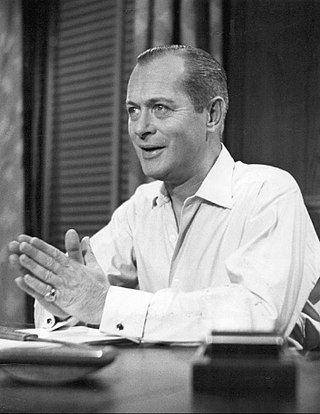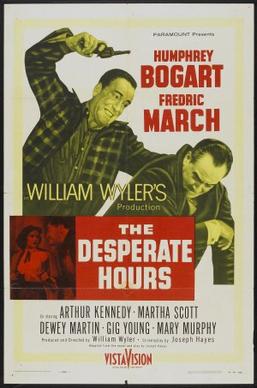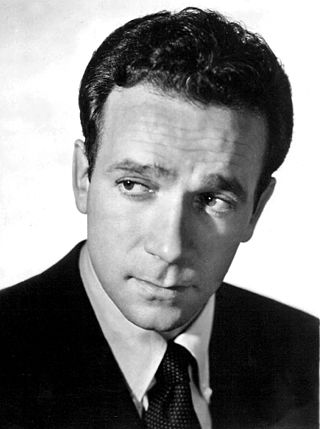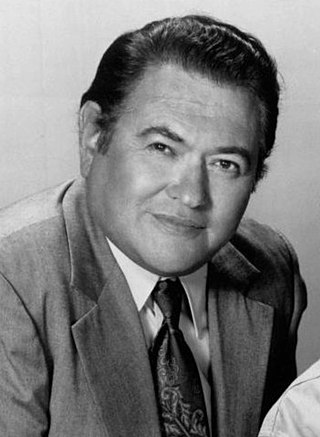Related Research Articles

John Arthur Kennedy was an American stage and film actor known for his versatility in supporting film roles and his ability to create "an exceptional honesty and naturalness on stage", especially in the original casts of Arthur Miller plays on Broadway. He won the 1949 Tony Award for Best Featured Actor in a Play for Miller's Death of a Salesman. He also won the Golden Globe for Best Supporting Actor for the 1955 film Trial, and was a five-time Academy Award nominee.

Jessie Royce Landis was an American actress. Her name is also seen as Jesse Royce-Landis. She remains perhaps best-known for her mother roles in the Hitchcock films To Catch a Thief (1955) and North by Northwest (1959).

Armstrong Circle Theatre is an American anthology drama television series which ran from June 6, 1950, to June 25, 1957, on NBC, and from October 2, 1957, to August 28, 1963, on CBS. It alternated weekly with The U.S. Steel Hour. It finished in the Nielsen ratings at number 19 for the 1950–51 season and number 24 for 1951–52. The principal sponsor was Armstrong World Industries.

Robert Montgomery was an American actor, director, and producer. He began his acting career on the stage, but was soon hired by MGM. Initially assigned roles in comedies, he soon proved he was able to handle dramatic ones, as well. He appeared in a wide variety of roles, such as the weak-willed prisoner Kent in The Big House (1930), the psychotic Danny in Night Must Fall (1937), and Joe, the boxer mistakenly sent to Heaven in Here Comes Mr. Jordan (1941). The last two earned him nominations for the Academy Award for Best Actor.

Emmett Evan "Van" Heflin Jr. was an American theatre, radio, and film actor. He played mostly character parts over the course of his film career, but during the 1940s had a string of roles as a leading man. Heflin won the Academy Award for Best Supporting Actor for his performance in Johnny Eager (1942). He also had memorable roles in westerns such as Shane (1953), 3:10 to Yuma (1957), and Gunman's Walk (1958), and as a bomb man in the disaster film Airport (1970), his last screen role.

William Brian de Lacy Aherne was an English actor of stage, screen, radio and television, who enjoyed a long and varied career in Britain and the United States.

Stephen McNally was an American actor remembered mostly for his appearances in many Westerns and action films. He often played hard-hearted characters, criminals, bullies, and other villains.

The Desperate Hours is a 1955 film noir starring Humphrey Bogart and Fredric March. It was produced and directed by William Wyler and based on the 1954 novel and 1955 play of the same name, written by Joseph Hayes, which were loosely built on actual events. The film takes place on the Northside of Indianapolis and took great pains to be accurate as to street names and locations within the city and Indiana in general.

Dane Clark was an American character actor who was known for playing, as he labeled himself, "Joe Average."

Patrick Barry Sullivan was an American actor of film, television, theatre, and radio. In a career that spanned over 40 years, Sullivan appeared in over 100 movies from the 1930s to the 1980s, primarily as a leading actor after establishing himself in the industry, and later as a character actor.

Margaret Hayes was an American film, stage, and television actress.

Simon Oakland was an American actor of stage, screen, and television.

Reed Hadley was an American film, television and radio actor.

Lois Arlene Smith is an American actress whose career spans eight decades. She made her film debut in the 1955 drama film East of Eden, and later played supporting roles in a number of movies, including Five Easy Pieces (1970), Resurrection (1980), Fatal Attraction (1987), Fried Green Tomatoes (1991), Falling Down (1993), How to Make an American Quilt (1995), Dead Man Walking (1995), Twister (1996), Minority Report (2002), The Nice Guys (2016), Lady Bird (2017), and The French Dispatch (2021).

The Fulton Theatre was a Broadway theatre located at 210 West 46th Street in Manhattan, New York City, that was opened in 1911. It was renamed the Helen Hayes Theatre in 1955. The theatre was demolished in 1982. After the former Little Theatre on 44th Street became the current Helen Hayes Theatre, the Fulton Theatre was sometimes referred to as the First Helen Hayes Theatre.

Ralph Ernest Dumke was an American comedian and actor who had an active career from the early 1920s up until his death in 1964. He rose to fame as part of a comedy duo with Ed East, performing nationally in vaudeville on the B. F. Keith Circuit from 1922-1932 and then headlining the nationally popular daily afternoon radio program "Sisters of the Skillet" on NBC Radio. In the 1940s Dumke worked as a character actor in Broadway musicals, and from 1949-1964 he worked in American film and television.
The Desperate Hours is a 1967 TV film. It was an adaptation of the 1954 novel The Desperate Hours.

Kelton Bradford Garwood, also known and credited as Jonathan Harper, and John Harper, was an American actor on stage, film and television, perhaps best known as undertaker Percy Crump on the western television show Gunsmoke.
Patricia Peardon was an American actress who originated the title role in the Broadway play Junior Miss. She later became a sculptor.

Rusty Lane, was a college professor who in his forties left academia to become a professional actor. He appeared in several Broadway productions during the 1940s and 1950s, including three years as an original cast member for Mister Roberts. He was in the original cast for another Tony award-winning play, The Desperate Hours. Lane also took up screen acting, performing in 21 films and making hundreds of televisions appearances from 1950 up through 1973, including as the star of the TV series Crime with Father, and as a regular cast member of the daytime serial The Clear Horizon.
References
- 1 2 3 4 Atkinson, Brooks (February 11, 1955). "Theatre: The Guests Came From Jail". New York Times. New York, New York. p. 20 – via NYTimes.com.
- 1 2 Chapman, John (February 12, 1955). "'The Desperate Hours' a Sizzling Melodrama with a Red-Hot Cast". Daily News. New York, New York. p. 181 – via Newspapers.com.
- ↑ Oppenheimer, George (February 18, 1955). "On Stage". Newsday (Suffolk edition). Melville, New York. p. 37 – via Newspapers.com.
- ↑ "Old Thespian Lunt, Neophyte Trio Presented 'Tony' Awards". The Post-Standard. Syracuse, New York. March 28, 1955. p. 2 – via Newspapers.com.
- ↑ Cannon, Betty (January 21, 1954). "Novel By Winter Resident Literary Guide Selection". The Bradenton Herald. Bradenton, Florida. p. 3 – via Newspapers.com.
- ↑ "News of the Theatre". Brooklyn Daily Eagle. Brooklyn, New York. March 4, 1954. p. 4 – via Newspapers.com.
- ↑ "'Desperate Hours' Author Reaps Delayed Rewards". Democrat and Chronicle. Rochester, New York. July 17, 1955. p. 77 – via Newspapers.com.
- ↑ "A New Tax Headache; Dance Festival Listed". Daily News. New York, New York. June 23, 1954. p. 91 – via Newspapers.com.
- ↑ Johnson, Erskine (January 7, 1955). "Old Movies Never Die, 'Fade Away' on TV". The La Crosse Tribune. La Crosse, Wisconsin. p. 11 – via Newspapers.com.
- ↑ Wilson, Barbara L. (January 16, 1955). "Busy Bob in 3 Jobs". The Philadelphia Inquirer. Philadelphia, Pennsylvania. pp. 103, 106 – via Newspapers.com.
- ↑ "Karl Malden In Thriller". Brooklyn Daily Eagle. Brooklyn, New York. November 2, 1954. p. 4 – via Newspapers.com.
- ↑ "Montalban in 'Heaven'; Hayes' Tickets on Sale". Daily News. New York, New York. December 13, 1954. p. 157 – via Newspapers.com.
- ↑ "Melodrama Set for Barrymore". Daily News. New York, New York. December 24, 1954. p. 26 – via Newspapers.com.
- ↑ "'Desperate' Men". Daily News. New York, New York. December 25, 1954. p. 184 – via Newspapers.com.
- ↑ "'Flowering Peach' Opening Tonight; Neway, Ribla Set". Daily News. New York, New York. December 28, 1954. p. 53 – via Newspapers.com.
- ↑ "May Pay Off". Daily News. New York, New York. May 15, 1955. p. 197 – via Newspapers.com.
- 1 2 "Appeals Court OKs Show Tax; 'Thieves' to End". Daily News. New York, New York. May 27, 1955. p. 45 – via Newspapers.com.
- ↑ Kilgallen, Dorothy (February 11, 1955). "Broadway". Star Gazette. Elmira, New York. p. 14 – via Newspapers.com.
- 1 2 "Solo Show at Plymouth; Weekend Cast Changes". Daily News. New York, New York. April 9, 1955. p. 97 – via Newspapers.com.
- ↑ Bolton, Whitney (May 27, 1955). "Looking Sideways". Buffalo Evening News. Buffalo, New York. p. 23 – via Newspapers.com.
- ↑ Freeman, Charles K. (July 25, 1955). "At the New York Theatres". The Standard Star. New Rochelle, New York. p. 11 – via Newspapers.com.
- 1 2 Russell, Fred (January 6, 1955). "Passing Show". The Bridgeport Post. Bridgeport, Connecticut. p. 68 – via Newspapers.com.
- 1 2 B. H. S. (January 8, 1955). "Have You Seen...". Meriden Record. Meriden, Connecticut. p. 10 – via Newspapers.com.
- ↑ Phillips, H. L. (January 13, 1955). "The Once Over". The Bridgeport Telegram. Bridgeport, Connecticut. p. 86 – via Newspapers.com.
- 1 2 Murdock, Henry T. (January 13, 1955). "Locust Offers Thriller In 'Desperate Hours'". The Philadelphia Inquirer. Philadelphia, Pennsylvania. p. 11 – via Newspapers.com.
- ↑ "Amusements". The Evening Sun. Baltimore, Maryland. January 22, 1955. p. 4 – via Newspapers.com.
- ↑ Kerr, Walter F. (February 14, 1955). "'Deperate Hour' Is Corn, But It Pops Briskly". Buffalo Evening News. Buffalo, New York. p. 7 – via Newspapers.com.
- ↑ Freeman, Charles K. (March 14, 1955). "At the New York Theatres". The Daily Item. Port Chester, New York. p. 8 – via Newspapers.com.
- ↑ "Roth Musical; Star Newman". Daily News. New York, New York. March 14, 1955. p. 156 – via Newspapers.com.
- 1 2 "Malden Quits, So 'Desperate Hours' to Fold". Daily News. New York, New York. August 4, 1955. p. 86 – via Newspapers.com.
- 1 2 McHary, Charles (August 1, 1955). "Plight of a Hit Show". Daily News. New York, New York. p. 108 – via Newspapers.com.
- 1 2 3 "Two Old Hits Leaving Ahead of New Season". Daily News. New York, New York. August 12, 1955. p. 409 – via Newspapers.com.